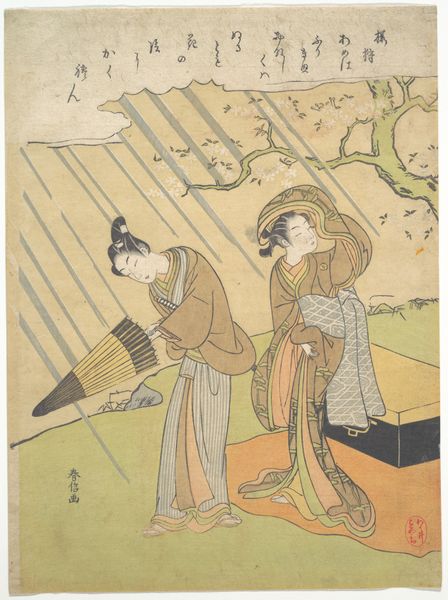
Osen of the Kagiya teahouse and an assistant reading a novelette c. 1769 - 1770
0:00
0:00
print, woodblock-print
# print
#
asian-art
#
ukiyo-e
#
figuration
#
woodblock-print
#
genre-painting
Dimensions: 25 × 5 in.
Copyright: Public Domain
Editor: So this woodblock print by Suzuki Harunobu, created around 1769 or 1770, depicts Osen of the Kagiya teahouse with an assistant, both engrossed in a book. There's a quiet intimacy in the shared reading experience. What's your perspective on this piece? Curator: This image, beyond its charming subject matter, reveals much about the social context and the production of art during the Edo period. Ukiyo-e prints like these were not simply aesthetic objects; they were commodities. Consider the materials: the woodblocks themselves, the pigments used for coloring. These were sourced, prepared, and applied by skilled artisans. The print is the final product of collaborative labor, involving the artist, block carver, printer, and publisher. How does understanding the means of production shift your appreciation of this work? Editor: It’s interesting to think about all the hands involved. It makes it feel less like a single vision and more like a collective effort. Did the accessibility of the print medium democratize art at all, making it available to a broader audience? Curator: Precisely. Ukiyo-e prints offered a relatively affordable form of art consumption, reflecting the tastes and desires of a growing urban population. Think about Osen, a celebrity in her time, and the 'novelette' she and her assistant are reading. These are elements of popular culture made accessible through mass production, even if we recognize a clear hierarchy in the access to consumption goods and status representation in that specific period. Do you notice how the lines between “high” art and popular culture get blurred in this instance? Editor: I do see that. So, beyond the pretty image, the print speaks volumes about the economic and social forces at play in Edo-period Japan. It reframes how I view it. Curator: Absolutely. And this approach encourages us to question how art functions within a specific historical and material context. Editor: Thanks, it definitely gave me a richer appreciation for this print!
Comments
No comments
Be the first to comment and join the conversation on the ultimate creative platform.













